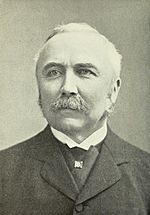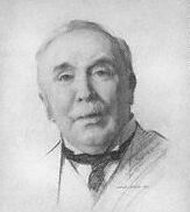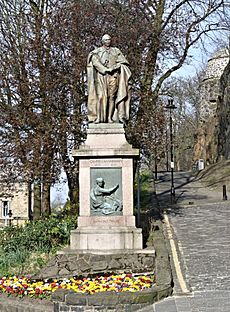Henry Campbell-Bannerman facts for kids
Quick facts for kids
Henry Campbell-Bannerman
|
|
|---|---|

Henry Campbell-Bannerman, c. 1890s
|
|
| Prime Minister of the United Kingdom | |
| In office 5 December 1905 – 3 April 1908 |
|
| Monarch | Edward VII |
| Preceded by | Arthur Balfour |
| Succeeded by | H. H. Asquith |
| Leader of the Opposition | |
| In office 6 February 1899 – 5 December 1905 |
|
| Monarch | Victoria Edward VII |
| Prime Minister | The Marquess of Salisbury Arthur Balfour |
| Preceded by | Sir William Vernon Harcourt |
| Succeeded by | Arthur Balfour |
| Leader of the Liberal Party | |
| In office 6 February 1899 – 22 April 1908 |
|
| Preceded by | Sir William Vernon Harcourt |
| Succeeded by | H. H. Asquith |
| Secretary of State for War | |
| In office 18 August 1892 – 21 June 1895 |
|
| Prime Minister | William Ewart Gladstone The Earl of Rosebery |
| Preceded by | Edward Stanhope |
| Succeeded by | The Marquess of Lansdowne |
| In office 6 February 1886 – 20 July 1886 |
|
| Prime Minister | William Ewart Gladstone |
| Preceded by | The Earl of Cranbrook |
| Succeeded by | William Henry Smith |
| Chief Secretary for Ireland | |
| In office 23 October 1884 – 25 June 1885 |
|
| Prime Minister | William Ewart Gladstone |
| Preceded by | George Otto Trevelyan |
| Succeeded by | Sir William Hart Dyke |
| Additional positions | |
| Personal details | |
| Born | Henry Campbell 7 September 1836 Kelvinside House, Glasgow, Scotland |
| Died | 22 April 1908 (aged 71) 10 Downing Street, London, England |
| Resting place | Meigle Parish Church, Perthshire |
| Nationality | British |
| Political party | Liberal |
| Spouse | |
| Education | University of Glasgow Trinity College, Cambridge |
| Profession | Merchant |
| Signature | |
Sir Henry Campbell-Bannerman (born Henry Campbell; 7 September 1836 – 22 April 1908) was a British politician. He was a member of the Liberal Party. He served as the Prime Minister of the United Kingdom from 1905 to 1908. He was also the leader of the Liberal Party from 1899 to 1908.
Campbell-Bannerman was known as "CB". He strongly believed in free trade, which means countries can trade without special taxes. He also supported Irish Home Rule, which meant Ireland would have more control over its own laws. He wanted to improve social conditions, like reducing working hours for people.
In 1906, Campbell-Bannerman led the Liberal Party to a huge victory in the general election. This was the last time the Liberals won a majority of seats in the House of Commons. His government passed laws to help trade unions. They also introduced free school meals for children. Local councils were given power to buy land for farming.
He resigned as Prime Minister in April 1908 because he was very ill. He died just 19 days later at 10 Downing Street, the official home of the Prime Minister. He is the only Prime Minister to have died there.
Contents
Early Life and Education
Henry Campbell was born on 7 September 1836 in Glasgow, Scotland. He was the second son of Sir James Campbell and Janet Bannerman. His father was a successful businessman in the clothing trade. He also served as the Lord Provost of Glasgow from 1840 to 1843.
Campbell-Bannerman went to the High School of Glasgow. He then studied at the University of Glasgow and Trinity College, Cambridge. After finishing his studies, he joined his family's business. He became a partner in the company in 1860.
In 1871, Henry Campbell added "Bannerman" to his name. This was a requirement from his uncle's will, as he inherited an estate from him. He often asked his friends to call him "C.B." because he didn't like the long name. His older brother, James Alexander Campbell, was also a politician. He was a Conservative Member of Parliament.
Marriage and Personal Life
In 1860, Campbell-Bannerman married Sarah Charlotte Bruce. They lived in Glasgow and later in the countryside. The couple never had any children.
C.B. and Charlotte were very close. They spent a lot of time together and shared everything. Charlotte encouraged him to become a politician.
They often spent summers in Europe, especially in France. Campbell-Bannerman spoke French, German, and Italian fluently. He loved French culture and books. They also had a home in Scotland called Belmont Castle. Charlotte died in 1906, and Campbell-Bannerman was deeply affected by her loss.
Becoming a Member of Parliament
In April 1868, at 31 years old, Campbell-Bannerman tried to become a Member of Parliament (MP) for the Stirling Burghs area. He lost that election. However, in November 1868, he won the next election. He became the Liberal MP for Stirling Burghs and represented the area for nearly 40 years.
Campbell-Bannerman quickly moved up in government roles. He worked in the War Office (the department in charge of the army) from 1871 to 1874. He became the government's main speaker on defence issues. He also served as Chief Secretary for Ireland in 1884. This was an important job because there were many debates about Ireland governing itself.
He served as Secretary of State for War twice. During this time, he introduced an experimental eight-hour day for workers at a munitions factory. He also convinced the Duke of Cambridge, the Queen's cousin, to step down as Commander-in-Chief of the British Army. This earned Campbell-Bannerman a special honour called a knighthood.
Leading the Liberal Party
On 6 February 1899, Campbell-Bannerman became the leader of the Liberal Party in the House of Commons. This also made him the Leader of the Opposition.
The Second Boer War (1899-1902) caused problems within the Liberal Party. Some Liberals supported the war, while others did not. Campbell-Bannerman strongly criticized the "concentration camps" used by the British. He called them "methods of barbarism."
The Liberal Party later came together to oppose new laws. One big issue that united them was Joseph Chamberlain's idea for "Tariff Reform" in 1903. This idea would have put taxes on imported goods, which Campbell-Bannerman and other Liberals strongly opposed. They believed in free trade, where goods could be traded without such taxes.
In 1903, the Liberal Party made an agreement with the new Labour Representation Committee. They agreed not to compete against each other in certain elections. This helped both parties win more seats against the Conservatives. Campbell-Bannerman got along well with Labour leaders. He said he was "keenly in sympathy with the representatives of Labour."
Becoming Prime Minister
In December 1905, the Prime Minister, Arthur Balfour, resigned. King Edward VII then asked Campbell-Bannerman to form a government. At 69, he was the oldest person to become Prime Minister for the first time in the 20th century.
Some members of his own party tried to make him move to the House of Lords, which would have weakened his power. But Campbell-Bannerman handled this by giving important jobs to these politicians. He then immediately called a general election.
The Liberals won by a huge amount, gaining 216 seats. This was helped by the agreement with the Labour Party and the divisions within the Conservative Party. Campbell-Bannerman was the last Liberal leader to win a clear majority in the House of Commons. This big win made him a much stronger Prime Minister.
Campbell-Bannerman was the first First Lord of the Treasury to be officially called "Prime Minister." This title became official five days after he took office. In 1907, he also became the "Father of the House." This title goes to the MP who has served the longest without interruption. He is the only Prime Minister to hold both titles at the same time.
Social Reforms
Campbell-Bannerman wanted to improve life for ordinary people. He spoke about helping the poor, reducing unemployment, and improving working conditions. He believed that if workers lived in "darkness and misery," then society's wealth and learning were "but dust and ashes." He wanted "sunshine to stream in" and for people to have "pure and unadulterated" food and water.
His government allowed local councils to provide free school meals for children. They also made trade unions stronger with the Trade Disputes Act 1906. The Workmen's Compensation Act 1906 gave workers the right to compensation if they were injured at work. The Probation of Offenders Act 1907 allowed young offenders to be supervised in the community instead of going to prison.
Campbell-Bannerman also met with women's suffragist groups. These groups wanted women to have the right to vote. While he was sympathetic, he said his cabinet would object to this change at the time.
Foreign Affairs
Campbell-Bannerman wanted to limit military weapons. In 1907, he wrote an article about reducing naval arms between Germany and Britain. However, this effort was not very successful.
In 1906, he caused a small diplomatic issue with Russia. He said, "The Duma is dead; long live the Duma!" after the Russian Tsar dissolved their parliament. Despite this, his time as Prime Minister saw an agreement with Russia in 1907.
His government also gave self-government to the Boer states (Transvaal and Orange River Colony) within the British Empire. This led to the creation of the Union of South Africa in 1910. Many people, including the first South African Prime Minister, believed this act helped heal the wounds of the Anglo-Boer War.
Campbell-Bannerman's Government
Here are some of the important people in Campbell-Bannerman's government:
- Sir Henry Campbell-Bannerman – Prime Minister and Leader of the House of Commons
- The Lord Loreburn – Lord Chancellor (chief legal advisor)
- H. H. Asquith – Chancellor of the Exchequer (in charge of money)
- Herbert Gladstone – Secretary of State for the Home Department (in charge of internal affairs)
- Sir Edward Grey – Secretary of State for Foreign Affairs (in charge of relations with other countries)
- Richard Haldane – Secretary of State for War
- John Morley – Secretary of State for India
- David Lloyd George – President of the Board of Trade (in charge of business and trade)
- John Burns – President of the Local Government Board (in charge of local councils)
Retirement and Death
After 1907, Campbell-Bannerman's health got worse. He had several heart attacks. He resigned as Prime Minister on 3 April 1908. His Chancellor, H. H. Asquith, took over as Prime Minister.
Campbell-Bannerman remained an MP and Liberal Party leader. He continued to live at 10 Downing Street for a short time. However, his health quickly declined. He died on 22 April 1908, just 19 days after resigning. His last words were "This is not the end of me." He is the only former Prime Minister to die inside 10 Downing Street.
He was buried in the churchyard of Meigle Parish Church in Scotland, near his home.
Legacy and Remembrance
When Campbell-Bannerman died, people mourned him. The leader of the Irish Nationalist Party, John Redmond, said that Ireland had "lost a brave and considerate friend." A trade union leader, Robert Smillie, called him one of the greatest men he had ever met.
Many historians see Campbell-Bannerman as a true Liberal. He believed in peace, careful spending, and reform. He was genuinely concerned about poor people. He supported measures like protecting trade unions, giving pensions to older people, and improving housing in cities.
There is a bronze statue of Campbell-Bannerman in Stirling, Scotland. His bronze bust is in Westminster Abbey in London. There is also a blue plaque outside his former house in London, which marks it as a place where a famous person lived.
Images for kids
See also
 In Spanish: Henry Campbell-Bannerman para niños
In Spanish: Henry Campbell-Bannerman para niños








